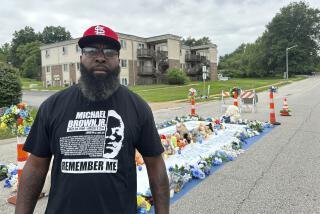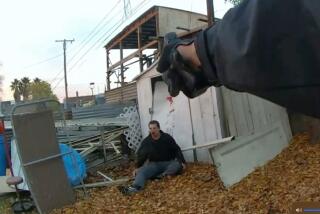Officer who shot Michael Brown didn’t know he was a robbery suspect
- Share via
Reporting from Ferguson, Mo. — The fatal encounter between a police officer and an unarmed young man began when the officer stopped the man because he was walking in the street, Ferguson’s police chief said Friday in a revelation that added to public anger and confusion over Michael Brown’s death.
The disclosure came hours after police released a report identifying Brown, 18, as a suspect in a robbery that occurred minutes before Brown was shot dead by Officer Darren Wilson, who was publicly identified Friday after nearly a week of public pressure.
The Brown family’s attorney accused Police Chief Thomas Jackson of character assassination for tying Brown to the crime.
“He chose to talk about something to darken up this man’s past,” attorney Anthony Gray said at news conference. “Let me be real clear to everyone here,” he added. “This family has never said Michael Brown was a perfect kid.”
Whatever Brown did, the family’s attorney and many residents who have taken part in protests and marches said he should not have ended up dead in the street, and they said the outcome spoke to racism in a police department that is overwhelmingly white. Brown was African American.
“I think it’s a coverup, basically,” said Jessica Holmes, who lives in Ferguson and who like many locals followed the flurry of news conferences that took place throughout the day, beginning with Jackson’s.
The renewed skepticism was echoed by others throughout the day and threatened to derail the relative calm that settled over the area Thursday, after Gov. Jay Nixon put Missouri State Highway Patrol Capt. Ron Johnson in charge of Ferguson’s security.
Angry protests punctuated by police in military gear throwing tear gas were replaced by an almost festive atmosphere Thursday night. By Friday afternoon, officials and the Brown family’s attorney were appealing for continued calm, even as they expressed anger and bewilderment at the latest turn of events.
“Do not take the bait from anybody who is trying to character assassinate Mike,” Gray said. “Don’t take that and begin to riot....This family is not for that.”
At a separate news conference, Jackson described Wilson, who has been placed on administrative leave, as a distinguished officer. He said the policeman was devastated by what had occurred and said Wilson suffered a swollen face during his encounter with Brown.
“He never intended for any of this to happen,” said Jackson, who also said that his “heart goes out” to the Brown family. “I can’t imagine what they’re going through.”
Nobody answered the door of Wilson’s red brick house Friday. “He’s not there,” said one police officer parked nearby, who was not authorized to speak to the media. “You’re probably wasting your time if you’re hoping for him to come back,” another officer said. “Let me ask you: Would you stay there?”
According to Jackson, Wilson had just finished responding to a call that was unrelated to the robbery when he came upon Brown and a second man. Wilson stopped them because they were “walking down the middle of the street,” Jackson said.
After the news conference, the chief told the St. Louis Post-Dispatch that Wilson was aware that cigars had been taken in the robbery of a store nearby, but did not know Brown and the other man, Dorian Johnson, might be suspects. Jackson said Wilson then saw cigars in Brown’s hand and realized it might be connected.
Police have said that when Wilson tried to get out of his vehicle, Brown pushed him back into the car, then entered it and began fighting for the officer’s gun. A shot was fired inside the car. Wilson and Brown got out of the vehicle, and the fatal shooting occurred, police have said.
Witnesses, including Johnson, say that Wilson made the first move toward Brown. Johnson said the officer ordered the two to “get the eff onto the sidewalk,” then grabbed Brown around the neck. Another witness, Piaget Crenshaw, said she saw police chase Brown. “They shot him and he fell,” Crenshaw said.
Police released a copy of a police report on a call that was received regarding a strong-arm robbery that occurred at a convenience store minutes before the shooting. Portions of the incident were captured by surveillance cameras. Jackson did not identify Brown as a suspect in that incident, but the police report did.
According to the report, Brown and Johnson entered a convenience store on Aug. 9. It said information from three surveillance cameras, a clerk and a patron in the store, whose names were redacted, indicated that Brown handed a box of cigars to Johnson.
As Johnson set the cigars on the counter, “Brown turns away from the counter with another box of … cigars and walks towards the exit door,” the report says. It goes on to describe an altercation between Brown and someone who came out from behind the counter and “stands between Brown and the exit door.”
“Brown aggressively pulls” the person toward him “and then immediately pushes him back into a display rack,” the report said. “Brown towers over” the person, “appearing to intimidate him,” it said. According to the report, Brown then followed Johnson out the door. Johnson was not charged with a crime, Jackson said.
When still photographs of the robbery were shown on a television at a nearby McDonald’s, viewers started comparing details of the suspect’s clothing to what Brown was wearing when he was shot and killed, arguing that Brown wasn’t the man shown in the pictures.
Outside, the Rev. Erick Winston, 42, a minister in Ferguson, said he had brought his daughter to Jackson’s news conference “just to see how the process goes, so that the facts come out.”
Of the robbery revelation, Winston said, “Even if he was a robbery suspect, he was still unarmed. The procedure [for police dealing with robbery suspects] is to call for backup. How this ended was totally uncalled for, regardless of whether he was a suspect, and if he did it at all, we don’t know.”
Local authorities are investigating the case, as are the FBI and the U.S. Justice Department.
Johnson, the Highway Patrol captain, offered his own criticism of the police department’s release of the information, expressing concern that it had given out details of the robbery without answering questions about it or Brown’s alleged involvement.
“These are two separate issues,” Johnson said of the robbery and Brown’s death. “I’m not going to say one justifies the other. I think if we’re going to give answers, we need not give hints. We need to say it.”
He and Nixon appeared before the media and an impassioned crowd of citizens for a news conference that exposed the simmering anger and distrust among many residents.
“We have children and families that we love. If we cannot trust our police officers, who can we trust?” Michelle Foster, who lives in neighboring Florissant, asked Nixon.
Nixon said people should look to Johnson, who grew up in the community and who has been on the streets reaching out to angry residents.
Foster was skeptical.
“This distrust has been going on for so long it’s going to take many years” to rebuild, she said later.
Another resident, Curtis Royston III, expressed doubts in Johnson’s ability to lead Ferguson through the turmoil unless he could guarantee an improvement over police in disseminating information to the public.
Otherwise, Royston predicted more violence because “we’re back where we were before.”
Nixon was asked whether he thought heavily armed Ferguson police had mishandled the situation after Brown’s shooting. He said no. But he described the community reaction as “an appropriate outpouring of angst,” and said the focus should be on how and why Brown died.
He also said that the investigation would take time.
“I think there are going to be some bumps along this road to justice,” Nixon said. “I think there are going to be some moments of angst between now and the finish line.”
Hennessy-Fiske and Pearce reported from Ferguson, Susman from New York. Times staff writer Maya Srikrishnan in Los Angeles contributed to this report.
More to Read
Sign up for Essential California
The most important California stories and recommendations in your inbox every morning.
You may occasionally receive promotional content from the Los Angeles Times.













